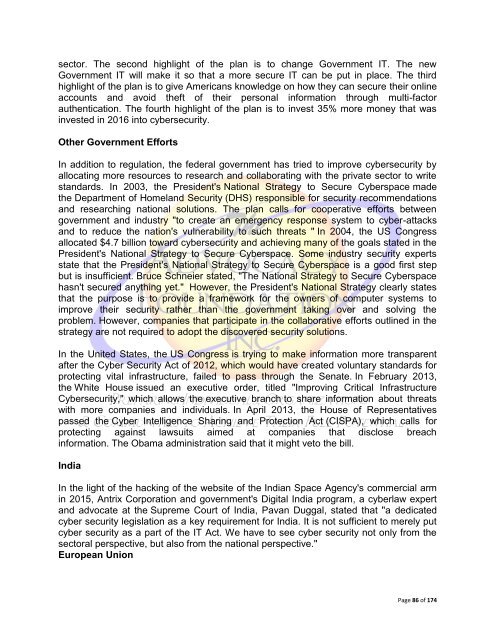International Cyber Terrorism
International Cyber Terrorism
International Cyber Terrorism
- No tags were found...
Create successful ePaper yourself
Turn your PDF publications into a flip-book with our unique Google optimized e-Paper software.
sector. The second highlight of the plan is to change Government IT. The new<br />
Government IT will make it so that a more secure IT can be put in place. The third<br />
highlight of the plan is to give Americans knowledge on how they can secure their online<br />
accounts and avoid theft of their personal information through multi-factor<br />
authentication. The fourth highlight of the plan is to invest 35% more money that was<br />
invested in 2016 into cybersecurity.<br />
Other Government Efforts<br />
In addition to regulation, the federal government has tried to improve cybersecurity by<br />
allocating more resources to research and collaborating with the private sector to write<br />
standards. In 2003, the President's National Strategy to Secure <strong>Cyber</strong>space made<br />
the Department of Homeland Security (DHS) responsible for security recommendations<br />
and researching national solutions. The plan calls for cooperative efforts between<br />
government and industry "to create an emergency response system to cyber-attacks<br />
and to reduce the nation's vulnerability to such threats " In 2004, the US Congress<br />
allocated $4.7 billion toward cybersecurity and achieving many of the goals stated in the<br />
President's National Strategy to Secure <strong>Cyber</strong>space. Some industry security experts<br />
state that the President's National Strategy to Secure <strong>Cyber</strong>space is a good first step<br />
but is insufficient. Bruce Schneier stated, "The National Strategy to Secure <strong>Cyber</strong>space<br />
hasn't secured anything yet." However, the President's National Strategy clearly states<br />
that the purpose is to provide a framework for the owners of computer systems to<br />
improve their security rather than the government taking over and solving the<br />
problem. However, companies that participate in the collaborative efforts outlined in the<br />
strategy are not required to adopt the discovered security solutions.<br />
In the United States, the US Congress is trying to make information more transparent<br />
after the <strong>Cyber</strong> Security Act of 2012, which would have created voluntary standards for<br />
protecting vital infrastructure, failed to pass through the Senate. In February 2013,<br />
the White House issued an executive order, titled "Improving Critical Infrastructure<br />
<strong>Cyber</strong>security," which allows the executive branch to share information about threats<br />
with more companies and individuals. In April 2013, the House of Representatives<br />
passed the <strong>Cyber</strong> Intelligence Sharing and Protection Act (CISPA), which calls for<br />
protecting against lawsuits aimed at companies that disclose breach<br />
information. The Obama administration said that it might veto the bill.<br />
India<br />
In the light of the hacking of the website of the Indian Space Agency's commercial arm<br />
in 2015, Antrix Corporation and government's Digital India program, a cyberlaw expert<br />
and advocate at the Supreme Court of India, Pavan Duggal, stated that "a dedicated<br />
cyber security legislation as a key requirement for India. It is not sufficient to merely put<br />
cyber security as a part of the IT Act. We have to see cyber security not only from the<br />
sectoral perspective, but also from the national perspective."<br />
European Union<br />
Page 86 of 174
















